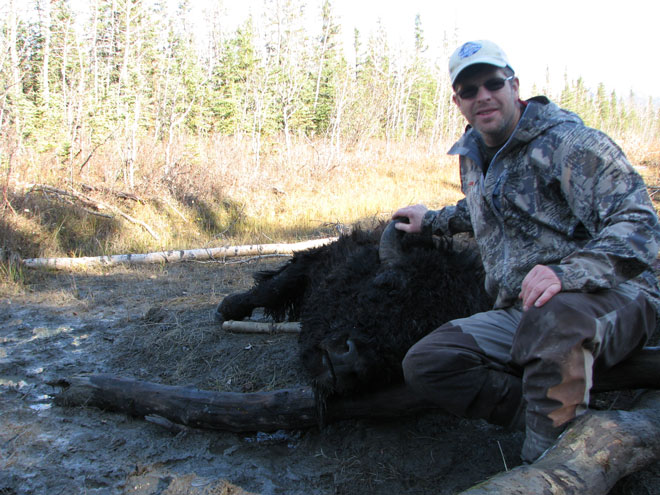Farewell Bison Hunt
by Rick Birch
Crossing a swift, two-foot-deep stream, fortunate to have thrown on my Caddis Waders that morning, I tried to advance as far as possible. My hunting partners, having no waders, watched anxiously from behind. I attempted to duck behind a chunk of driftwood and a scrawny little tree, and I watched in amazement as more than a dozen bison had moved into a clearing ahead, about 250- to 300 yards away. Approaching a bend in the Kuskokwim River, I longed to close the distance even more, but there was no cover ahead. These animals were not stopping for a picnic.
Most of the group of bison ran through 3- to 5 feet of swift, 6mph current like it was a walk in the park. Clearly these animals were not restricted and could travel across the river with ease. I had seen more bison coming. One large bull approaching the river had not yet crossed, but instead paused and turned to look back, seemingly waiting for others in his group to catch up.
As I propped myself on the driftwood, this massive bull hesitated. For a moment, he gave me a perfect broadside view. My Leopold vx6 2-12 scope provided a great view of this beast of an animal. The moment I had dreamed of had arrived.
Ben Reaves, Marc Deede and I had arrived at this remote spot on the south fork of the Kuskokwim River because of a chance drawing with the State of Alaska. Marc, a longtime family friend, had approached me the previous December, quite enthusiastic about sharing his passion for hunting and the outdoors. I expressed a few reservations about my inexperience and the unknown of how a years-ago back surgery would stand up to the rigors of large-game pursuits. We agreed together to take on such challenges. Several of us would apply for about 14 different big-game hunts.
I was blessed to get drawn for a Farewell Bison hunt. Many hunters I talked with told me I had just won the lottery. Time and time again, I heard the same phrase from others: “I have been putting in for bison for over 20 years and haven’t gotten one yet”. In 2014, the odds of being drawn for the September Farewell Bison hunt were less than 1%.
The logistics led down many winding roads. I worked for months, following leads and referrals from people I knew and trusted. I discussed many different options with hunting camps and flight operators. We finally chose an option that would be mostly do-it yourself, but with the flight support of Barney Anselment/ Magnuson Airways. Barney was highly regarded by everybody I talked to that knew him.
We flew to McGrath on Alaska Air Transit. We then met up with Barney, and he flew us and our gear to a tundra airstrip officially known as Rohn, Alaska. Barney had dropped off a 16-foot Aire cataraft ahead of time with some custom-fitted boards we had requested. On many occasions, Barney went out of his way to pick up supplies before we got there.
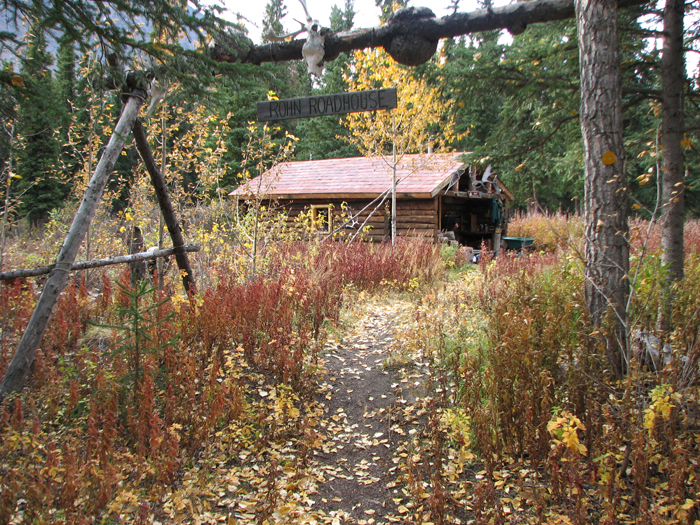 Flying along the south fork of the Kuskokwim was exhilarating. We spotted bison grazing along the river, a few bears and moose. We were in for a 68-mile float trip, and the adventure of a lifetime!
Flying along the south fork of the Kuskokwim was exhilarating. We spotted bison grazing along the river, a few bears and moose. We were in for a 68-mile float trip, and the adventure of a lifetime!
We arrived at the Rohn airstrip in the late evening. One of the Iditarod checkpoint cabins was just a couple hundred yards away. We organized our gear and spent the first night in the Rohn Roadhouse cabin. Talk about luxury in the wilderness. I joked with Ben and Marc that we should locate bison close by and stay at this cabin for a few days.
It was a privilege to share such a new adventure with friends I had known for more than 20- to 30 years. Ben was about half my age, and like me, this was his first hunt. Always full of enthusiasm, strong and resourceful, Marc and I had recruited Ben to come along on this trip.
Marc was the experienced hunter of our group. He is 10 years my senior and has over 20 years of hunting experience. Though he had hunted bison once before, this float trip would be a first for him. The three of us seemed a great combination of planning, knowhow and ingenuity to tackle the many challenges that were ahead.
I had plenty of experience with a powerboat, but not rowing on a river. I had sought out some help from Lenny Dipaulo in my hometown. Lenny had many years of guiding experience, running a drift boat, and he spent a day with me, during the summer, on the upper section of the Kasilof River. I was rowing and he provided advice about setting up and avoiding hazards in the river. That turned out to be incredibly valuable.
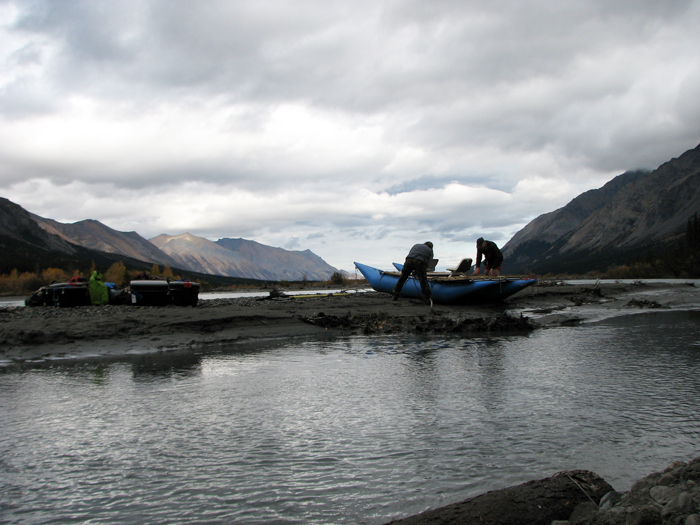 Day two on the south fork of the Kuskokwim started with us packing all of our gear to the river, adjacent to the Rohn airstrip. We spent the first several hours lashing the custom-cut boards that Barney Anselment had left us. We secured the boards with rope to the framework of the Aire cataraft. That would be suitable for 400 pounds of food/gear and three grown men. By early afternoon, we had set off on our floating adventure, excited for the unknown of what lay ahead.
Day two on the south fork of the Kuskokwim started with us packing all of our gear to the river, adjacent to the Rohn airstrip. We spent the first several hours lashing the custom-cut boards that Barney Anselment had left us. We secured the boards with rope to the framework of the Aire cataraft. That would be suitable for 400 pounds of food/gear and three grown men. By early afternoon, we had set off on our floating adventure, excited for the unknown of what lay ahead.
Just being on the river was awesome. We practiced our landing technique, which we decided needed some refinement—a ballet of sorts—timing a jump-off, with bowline in hand, as we oared toward a cut bank. Many times the river would not allow us to approach shore exactly where we wanted to. Practice makes…well, better! We stopped several times that first day of the float, breaking for lunch and even setting out on a hike to follow, believe it or not, bison tracks.
We ended day two not yet seeing any wildlife, but all the same inspired by Alaska’s beautiful wilderness. There was not another soul to be seen, except for the occasional plane that flew overhead. We figured it was Fish & Game monitoring activity in the area. We set-up camp and hoisted food into a tree. I jokingly predicted that a herd of bison should come by the front yard of our tent at about 9:45 a.m. We could take my bison and be on our way!
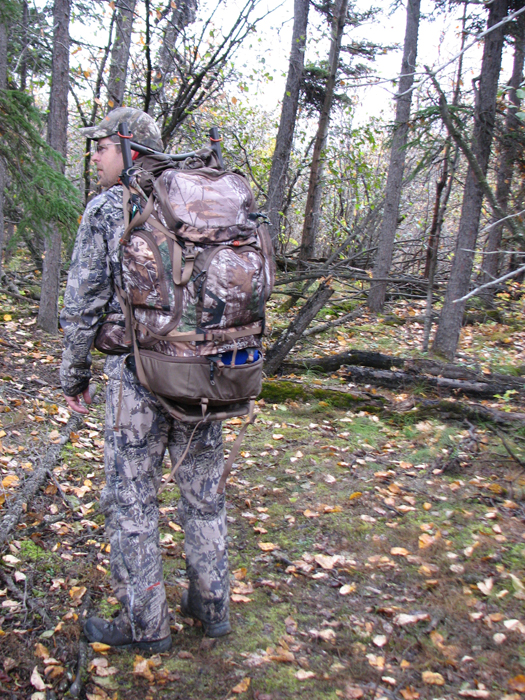
It was also moose-hunting season. We expected that most of the hunting pressure was a full day’s float and several miles away from the Kuskokwim. We did not know of any other airstrips with easy access to this stretch of river. We were truly remote.
The next morning, as Ben and Marc went to retrieve the food stash from the tree. I started searching the area with my Bushnell Elite 15x-45x 60mm Zoom spotting scope. I chased after Marc and Ben.
“Hey, guys, there are bison coming our way.”
In half disbelief, they came down and took a look for themselves. We hurriedly got out our guns and set out to intercept them. It was about 9:30 a.m., which made me think I might have called my shot, ala Babe Ruth.
Here I was within a trigger-pull of realizing a successful hunt, struggling to set-up for a shot, leaning on this chunk of driftwood. I was in awe of this full-grown bull. He was close to the river. I wanted to get a steady first shot. This particular bull seemed a little farther out than I had hoped for. I was also worried that he was too close to the river. If I did not score a solid shot with my first attempt, would he end up collapsing in the middle of the river? I was not steady, dancing all over my intended target. Call it a poor choice to lean on this driftwood, breathing too hard or whatever; I decided to pause for a moment, catch my breath and get a steadier setup. I also knew there were other animals coming.
This impressive bison I was watching started to move again, and to my surprise, a shot rang out. We were amazed that other hunters were close by. We had seen no sign of anyone else in the area. They had taken one of this herd, just another 100 yards away, and the animals were now off and running. Just like that, I lost a golden opportunity.
We launched our raft a couple hours later. We actually spotted this same herd several miles downriver. We tried to stalk close to them but did not get near enough for a shot. We followed by foot to see if they would settle down somewhere. In so doing we saw plenty of gorgeous country and sign that buffalo had been all over the area. We figured they had moved a long ways away.
Back to the raft, we floated for several more hours. Just rafting this river was rewarding in itself. I enjoyed the challenges, though we had a few tense moments, requiring us to work together to avoid obstructions. The south fork of the Kuskokwim is a braided river system. Reading the river and choosing a channel with the most water volume kept us from getting stuck in shallow water.
The third night, we floated the river until we found a campsite with good tree cover. We were close to Egypt Mountain, a place we had heard good things about. It was September 17; the temperatures were comfortably in the 40s during the day and probably mid 30s at night. We were seeing termination dust on the top of the mountains around us. There were bison tracks everywhere along the shore of the river. Surely I would get another chance?
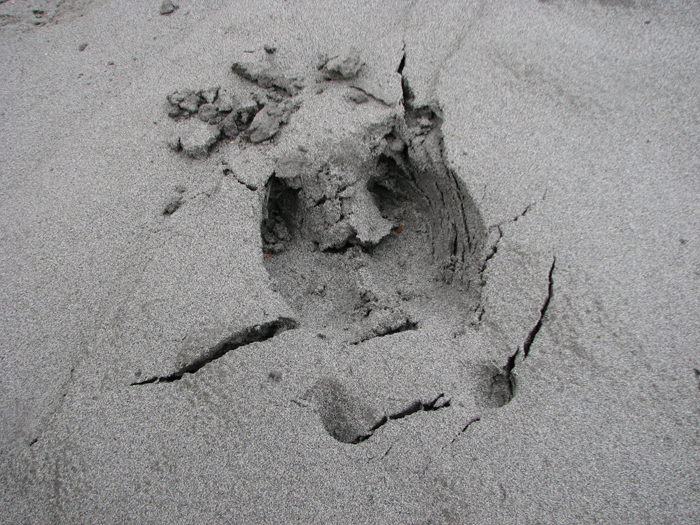 The fourth day started way too early. Marc heard a grunt just outside the tent at 2:30 a.m. He woke us up; we needed to be ready to shoo off a bear. Marc banged pots and pans together from inside the tent, and there were no more sounds to be heard. Marc stepped outside the tent and saw nothing by the light of his headlamp. The next morning we spotted a lone set of fresh bison tracks that had walked some 20- to 30 feet from our tent. The tracks showed that the animal took off running, most likely to the sounds of banging pans.
The fourth day started way too early. Marc heard a grunt just outside the tent at 2:30 a.m. He woke us up; we needed to be ready to shoo off a bear. Marc banged pots and pans together from inside the tent, and there were no more sounds to be heard. Marc stepped outside the tent and saw nothing by the light of his headlamp. The next morning we spotted a lone set of fresh bison tracks that had walked some 20- to 30 feet from our tent. The tracks showed that the animal took off running, most likely to the sounds of banging pans.
We spent the next day and a half hiking up the hills and mountainside. We found countless trails and byways beaten down to glacial rock. Bison had been trekking through here for years. Other than the early morning wakeup, we were not finding much fresh sign. The weather had turned colder, with a little bit of blowing snow. The snowline had moved down the mountain during the night. None of that mattered; the real concern was the opportunity I had chosen not to take. I did not want my lasting memory to be something I second-guessed for years. I was not going to be eligible for a bison draw again for another 10 years.
It was the afternoon of day 5. We floated through amazingly barren country, and I could imagine doing this float again, if only to share the scenery with others, and just take in the experience of the Alaska wilderness. This was becoming less about the hunt and more about the adventure.
Along the way we startled a dozen bison or so; they must have been 20- to 30 yards off the river, bedded down. As we talked quietly, floating down the river, a thunderous commotion broke loose somewhere along the bank. I instantly wondered if a moose was busting through trees frantically trying to escape a chasing grizzly bear. We were floating on the water and could feel the percussion in the air, but it was of the stampeding bison, busting through the trees, trying to get away from us.
A couple hours later it was easy to choose a place to camp. We spotted a herd of 30 bison grazing on a ledge along the river, about 400 feet above water level. We watched these majestic animals as we floated by; they seemed to know that we were not much of a threat from our position below. As we floated around the next corner, on the opposite bank, there were another 100 or so bison hanging out on the river flats. As we got close, they all started running into the thick brush and up the hillside.
Day six was another day of exploration. We hiked through thick woods in the Farewell Burn area. We found Farewell Lake, crossed and followed the Iditarod Trail and explored hillsides where we had seen the bison heading the night before. They seemed to have some experienced members in the herd, animals that were good at keeping away from us.
The next morning we got up early and hiked a hillside to glass and see what we could find. We spotted some bison upriver about a half-mile away. It was September 21, my birthday; and our days were running out. I figured today was our last chance to have time to deal with an animal. We had a lot of river to cover in order to catch our flight for home.
We started a roundabout trek through the woods, keeping downwind of these animals. By the time we got there, they were gone. We continued our search, quietly stalking through the timber.
By 5p.m., I was ready to go back to the flats and see what might be out there, while Marc and Ben wanted to push on another half-hour. That half -hour breezed by. Ben waved to get our attention. We were flanked to either side of Ben. He had spotted a bull, lying just 65 yards ahead of our position.
The bison got up to investigate. We were all in camouflage and he was facing directly toward us. I watched him from a kneeling position, quiet as I could, waiting for him to turn. It seemed like 15- to 20 seconds of him staring at us before he turned slightly. It was a quarter-facing angle, a tough shot, but I took it. I got him in the liver with a Remington A-Frame 200-grain bullet fired from a .300 Winchester magnum. I also hit him in the vital area with another shot. He stood there as if nothing had happened. He eventually stumbled sideways a few feet, just enough to fall halfway into the creek, like a final act of defiance.
Our work had just begun. We spent from 5:30 that evening until 3:30 a.m. processing what we could, getting some sleep and then coming back to finish the job. Because of the creek, we needed to remove the guts and quarters that were not partially in the water. With extra weight gone, we struggled, using ropes, pulleys and trees to cantilever and flip this huge animal out of the water. The whole process took about 48 hours before we were packed and ready to start floating downriver.
Our plan had been to find a bison, and if not successful, see if we could harvest a moose, working together as a team, no matter the results. Now we had more than enough game to handle floating out the rest of the way to Nikolai and then getting back to Anchorage. This beautiful bull weighed about 1,200- to 1,300 pounds.
We had brought along a PR-49 Packraft. This awesome little raft, packed in a small duffel bag, weighed only about 15 pounds. It turned out to be a key piece of equipment for the trip. We were more than a mile upriver from both our camp and the Aire cataraft. Most importantly, the kill site was at most a half-mile from a stream that channeled into the main river. We were able to pack out the game meat, hide and shoulder mount to the stream and then float everything in two trips to our main camp. The packraft could hold up to 850 pounds.
Ben was to paddle out on the packraft, while Marc and I carried the rest of the weight on the Aire cataraft.It was 5 p.m. on day 9 before we started floating downriver again. Two more nights were spent on the river before we got close to the town of Nikolai. We had rented a satellite phone from Katchemak Electric in Kenai. It was a crucial piece of equipment to keep in touch with our pilot, Steve Nikolai, and our families back home.
Steve and Jim Nikolai actually came to meet us on the river. We were very impressed with Steve and his son’s hospitality. They were willing to jump in and help us, whatever needed to be done. Barney was already landing and made two quick flights to McGrath, just in time for a Northern Air Cargo haul to Anchorage. Amazingly, all our stuff was on its way, while we settled in for a night’s stay at the lodge in Nikolai. We had missed our return flight, but Alaska Air Transit was able to get us out the very next day.
When in Anchorage the next day, we picked up the meat from Northern Air Cargo cold storage and got it to Indian Valley Meats for processing, all before closing time. We also met, after hours, with Larry Golden at About Alaska Wildlife Art by Golden Taxidermy.
We worked with lots of good people and made new friends. I will have great memories of my first-ever hunt. I definitely gained an appreciation for the majestic Plains bison, Alaska’s small villages and the tremendous hunting opportunities in our wonderful state.

